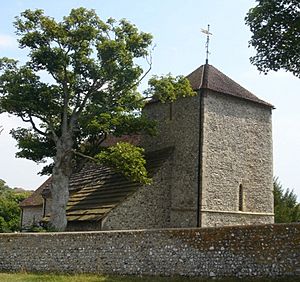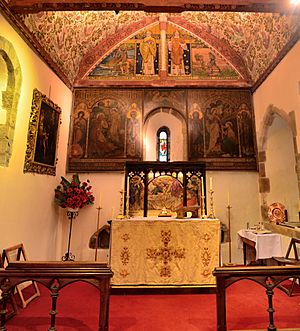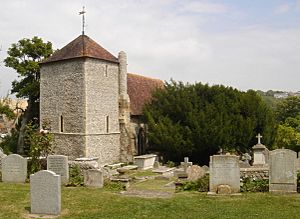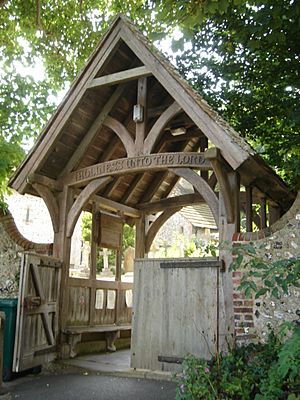St Wulfran's Church, Ovingdean facts for kids
Quick facts for kids St Wulfran's Church |
|
|---|---|

The church from the northwest
|
|
| Denomination | Church of England |
| Website | www.stwulfrans.org.uk |
| History | |
| Dedication | St Wulfran |
| Administration | |
| Parish | Ovingdean |
| Deanery | Rural Deanery of Brighton |
| Archdeaconry | Chichester |
| Diocese | Chichester |
| Province | Canterbury |
St Wulfran's Church is an old church in Ovingdean, a village now part of Brighton and Hove in England. It is named after Wulfram of Sens, a French archbishop from the 600s.
Some parts of the church were built way back in the early 1100s. Because it is so old and important, the church is a "Grade I listed building." This means it is a very special building with great history or design.
Contents
History of St Wulfran's Church
A church was already in Ovingdean when the Domesday Book was written in 1086. The Domesday Book was a big survey of England ordered by William the Conqueror. It called the church a "little church."
Early Building and Changes
The church was rebuilt in the early 1100s. Most experts agree that no parts of the older Anglo-Saxon church remain today. The main parts of the church, called the chancel (the area around the altar) and the nave (where people sit), come from this 12th-century building.
In the 1200s, a tower was added to the west end of the church. A side section, called an aisle, was also added on the south side. This aisle was connected to the nave by two archways.
Fire and Restoration
The south aisle is no longer there, and no one is sure what happened to it. However, old burn marks on the south wall of the nave suggest it was damaged by fire. This fire might have been caused by French raiders in 1377. These same raiders also destroyed a nearby church, St Margaret's, in Rottingdean. A stone tablet inside St Wulfran's Church also mentions this fire.
For several centuries, not much changed at the church. Then, in the 1800s, like many old churches, St Wulfran's had a big "Victorian restoration." This means it was repaired and updated between 1865 and 1867.
During this time, the chancel arches were rebuilt to create one large arch with two smaller ones. All the old pews (church benches) were replaced. New wood panels and roof timbers were added in the chancel. These were designed and painted by Charles Eamer Kempe. He was born in Ovingdean and became a famous designer of stained glass windows.
Kempe's Contributions
Before he passed away in 1907, Charles Eamer Kempe created seven stained glass windows for the church. He also designed a rood screen for the chancel. This screen was carved in a German village called Oberammergau, which is known for its woodcarving.
Other painted panels from the 1800s can be seen throughout the church. They show different scenes from the Bible. The reredos (a decorated screen behind the altar) was also designed in the late 1800s. It shows figures like St Richard of Chichester. The painting above the altar, showing St Wilfred and St Richard, was painted between 1957 and 1963 by Maude Emily Bishop.
Later Additions
In 1907, a chapel was built on the south side of the church. A space for this chapel had been planned since the 1100s. A vestry (a room for clergy and church items) was added in the mid-1980s. It was designed to match the church's style.
Churchyard and Famous People
The churchyard surrounds the church on three sides. It is home to a very old yew tree, which might be as old as 1,000 years!
Many interesting people are buried or remembered in the churchyard:
- William Willett, who campaigned for daylight saving time, is remembered on a family memorial. Daylight saving time is when clocks are moved forward in spring and back in autumn to make better use of daylight.
- Magnus Volk, an inventor born in Brighton, is buried here. He was a pioneer in electrical engineering. He built an early electric car and the Volk's Railway, which is the oldest electric railway still running in the world.
- Members of the Kempe family, including Charles Eamer Kempe himself, are also buried in the churchyard.
- Nathaniel Kemp, who built Ovingdean Hall in the 1700s, shares a tomb with his wife Martha. Charles Kempe designed their tombstone and was later buried there too.
- The grave of Helena Normanton can also be found. She was the first woman to work as a barrister (a type of lawyer) in the United Kingdom. She fought for women's rights, like allowing women to use their maiden names professionally. She also helped the nearby University of Sussex.
- The Jex-Blake family has a large, fancy tomb in the churchyard. Although she is not buried there, Sophia Jex-Blake is remembered on the memorial stone. She became one of the first female doctors in the UK, even though it was very difficult at the time. She also helped start medical schools for women in London and Edinburgh.
Rare Dedication
The dedication to Wulfram of Sens is very rare. Only one other church in England still has this dedication: the parish church in Grantham, Lincolnshire.
There might be a connection between the two churches through William de Warenne, 1st Earl of Surrey. He was a powerful Norman nobleman in the 1000s and owned land in both Ovingdean and Grantham.
Architecture of St Wulfran's Church
St Wulfran's Church is built entirely of flint, which is a hard stone. The corners of the walls have narrow stone blocks called quoins. While many churches in Sussex use some flint, St Wulfran's is the only one in the historic county made completely of flint.
The roof was originally made of slate, but most of it has been replaced with tiles. The church tower has two sections and is topped with a shallow pyramid-shaped roof. This design is known as the "Sussex Cap."
Windows and Arches
There are lancet windows (tall, narrow windows with pointed tops) of different sizes all around the church and in the tower. Charles Eamer Kempe's beautiful stained glass can be seen in several of these windows.
Inside, you will find many arches. Some have pointed tops and chamfered (beveled) edges. For example, there are three arched entrances to the chapel on the south side. There is also a blocked-up archway that used to lead to the old south aisle.
Churchyard Entrance
You enter the churchyard on the east side through a lychgate. This is a covered gateway with a steep roof and seats inside. Carved on one of the wooden beams is the phrase: "Holiness unto the Lord."
St Wulfran's Church Today
St Wulfran's Church was given its Grade I listing on October 13, 1952. This means it is protected as a very important historic building.
The church serves a rural area. Ovingdean village is the main place where people live in the parish. The parish also includes parts of Woodingdean, the Whitehawk estate, and Rottingdean. It also covers the East Brighton Golf Club and the surrounding downland hills.
See also
- Grade I listed buildings in Brighton and Hove
- List of places of worship in Brighton and Hove




